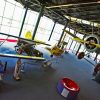calsfoundation@cals.org
Floyd Hurt Fulkerson Jr. (1921–)
Floyd Hurt Fulkerson Jr. is a highly honored veteran who served with the U.S. Army Air Forces in World War II. The grandson of an Arkansas Civil War commander, he became a businessman and real estate developer in central Arkansas.
Floyd Hurt Fulkerson was born on April 6, 1921, in Little Rock (Pulaski County), one of three children of Floyd and Georgia Fulkerson. Fulkerson’s maternal grandfather was Colonel George F. Baucum, commanding officer of the Confederate Eighth Arkansas Regiment during the Civil War. His elder brother, George Baucum Fulkerson, was a Rhodes Scholar from Sewanee University who served as a member of the Nuremberg Military Tribunal and prosecuted Nazi officers for war crimes.
Fulkerson attended Little Rock High School, Sewanee Military Academy, and the University of Arkansas (UA) in Fayetteville (Washington County). In December 1941, following the Pearl Harbor bombing, Fulkerson enlisted in the Aviation Cadet Program of the U.S. Army Air Forces. He was commissioned a second lieutenant on September 29, 1942.
Fulkerson was deployed to Port Moresby, New Guinea, where he flew combat as a B-25 pilot. He was transferred to a new fighter group, the 475th Air Group of the 431st Fighter Squadron. His airplane was the J Series Lightning P-38, a single-seat aircraft equipped with four 50-caliber machineguns and a 20mm cannon. The P-38 had a top speed of 408 knots, as fast as any airplane in military service at that time. Fulkerson’s P-38 was emblazoned with his choice of nose art, reading “Who’s Next…?”
During his time with the 475th Air Group, Fulkerson flew as wingman with such notables as Major Richard Bong and Major Tommy McGuire, the two top aces for the United States in the Pacific theater, as well as with Charles Lindbergh.
On December 25, 1944, Fulkerson, who had completed 124 missions, took off in a formation of fifteen P-38s escorting B-24s. The formation encountered about fifty Japanese fighter planes. In the air battle that followed, Fulkerson shot down two enemy planes, aided a crippled P-38, and twice drove enemy attackers away from other P-38s. When his own plane was disabled, Fulkerson landed in a rice field behind enemy lines. His plane caught fire during the crash landing, but he escaped moments before the plane exploded.
He was assisted by Filipino guerrillas who took him to a camp in the Sierra Madre Mountains. There, he joined other Americans from the Office of Strategic Services (forerunner of the Central Intelligence Agency). Over the next six weeks, Fulkerson participated in commando missions, including the nighttime dynamiting of a bridge. During this time, Fulkerson used a water buffalo to clear a landing strip in the jungle. When the airstrip was completed and a radio signal was sent to the U.S. base at Luzon, reconnaissance planes rescued Fulkerson and others.
Fulkerson suffered compression fractures in his back in the plane crash, and the injuries became more problematic. He was discharged from military service in 1946 at the rank of captain, having been credited with the destruction of four enemy aircraft in aerial combat, plus five more on the ground while strafing enemy airfields. He was recognized for saving the lives of naval personnel by intercepting and destroying an enemy kamikaze aircraft while braving anti-aircraft fire from the U.S. Navy ships below. For this heroic action, he was awarded the Silver Star from the U.S. Navy. Fulkerson was also awarded the Bronze Combat Star by the U.S. Army for his ground activity in the Philippines. He received the Distinguished Flying Cross with Oak Leaf Clusters for shooting down two airplanes in one mission; the Air Medal for shooting down a bomber in New Guinea; and two Purple Heart medals (one for being shot down in 1944 and one for an injury received when his P-38 canopy was shot off during an air battle).
Returning to Arkansas, Fulkerson spent the next four years serving in the National Guard, flying P-51s. In 1946, he took over management of the Baucum Plantation, a family farming enterprise that had operated since 1888. He retired from military service in 1950. He moved to Little Rock in 1958 to begin work in the real estate business, starting with Little Rock–based Rector Phillips Morse but later establishing his own firm: Fulkerson & Co. He was instrumental in establishing the Longlea and Pleasant Valley neighborhoods and the Second Presbyterian Church, all in Little Rock.
Fulkerson also helped establish office warehouses in Little Rock, locating the first off Cantrell Road near Cajun’s Wharf. He was appointed to the Arkansas State Plant Board by Governor Orval Faubus and served in that group for twelve years. In 1995, he was inducted into the Arkansas Aviation Hall of Fame.
Fulkerson is married to Brenda Mitchell Fulkerson of Carthage (Dallas County), and he has four children from a previous marriage.
For additional information:
Brandon, Phyllis. “Floyd Hurt Fulkerson.” Arkansas Democrat-Gazette, December 25, 1994, p. 1D, 6D.
Dejanovich, John. “Wingman to the Aces, Lt. Floyd Fulkerson: Ultimate Wingman.” Flight Journal (December 2012): 42–49.
“In Their Words.” AETN WWII Oral History project, recorded January 26, 2006. Arkansas Educational Television Network, Conway, Arkansas.
Wentling, Nikki. “Lost Dogfight a Christmas Memory.” Arkansas Democrat-Gazette, December 25, 2014, p. 1B, 6B.
Marvin Schwartz
Little Rock, Arkansas
 Aviation
Aviation Business, Commerce, and Industry
Business, Commerce, and Industry Military
Military World War II through the Faubus Era, 1941 through 1967
World War II through the Faubus Era, 1941 through 1967




Comments
No comments on this entry yet.